1402LHS: Language, Culture, and Society - Language Planning Policy
VerifiedAdded on 2022/10/12
|11
|2672
|300
Essay
AI Summary
This essay provides a comprehensive analysis of language planning policies in Australia, with a specific focus on the National Policy on Language (NPL). The essay traces the historical development of language policies, from the White Australian Policy to the emergence of multiculturalism, which paved the way for the NPL. It explores the principles and characteristics of the NPL, including its goals of promoting English competency, supporting languages other than English, and fostering multiculturalism. The essay also examines the stages of language planning, including selection, codification, implementation, and elaboration, and reviews relevant literature on the topic. The conclusion emphasizes the effectiveness of the NPL in safeguarding cultural integrity and promoting multilingualism within Australian society. The essay highlights key concepts like assimilation, integration, and the importance of language planning in addressing sociopolitical needs and reducing linguistic disparities. The analysis also touches upon the role of education, curriculum design, and teacher training in supporting language policy implementation.
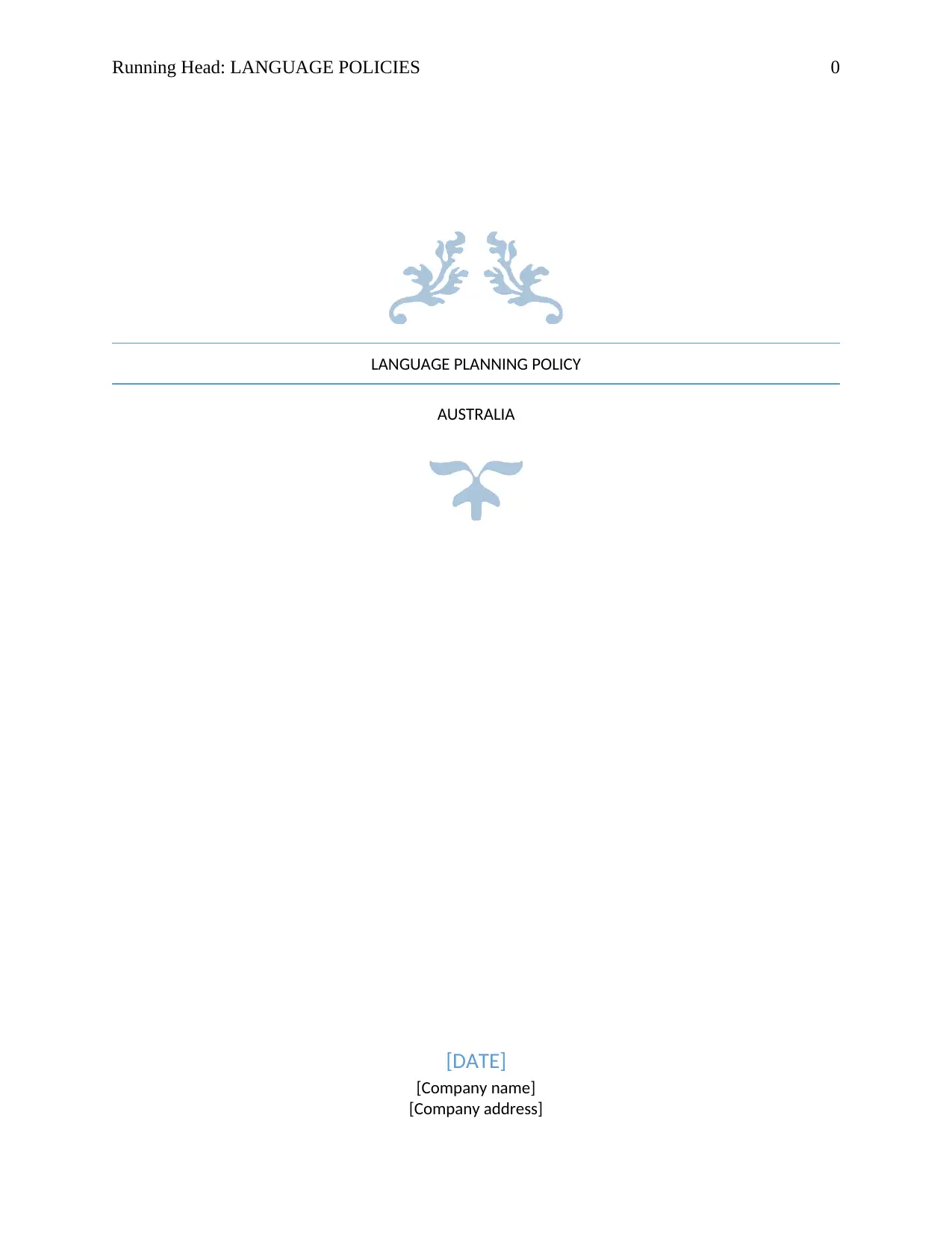
Running Head: LANGUAGE POLICIES 0
LANGUAGE PLANNING POLICY
AUSTRALIA
[DATE]
[Company name]
[Company address]
LANGUAGE PLANNING POLICY
AUSTRALIA
[DATE]
[Company name]
[Company address]
Paraphrase This Document
Need a fresh take? Get an instant paraphrase of this document with our AI Paraphraser
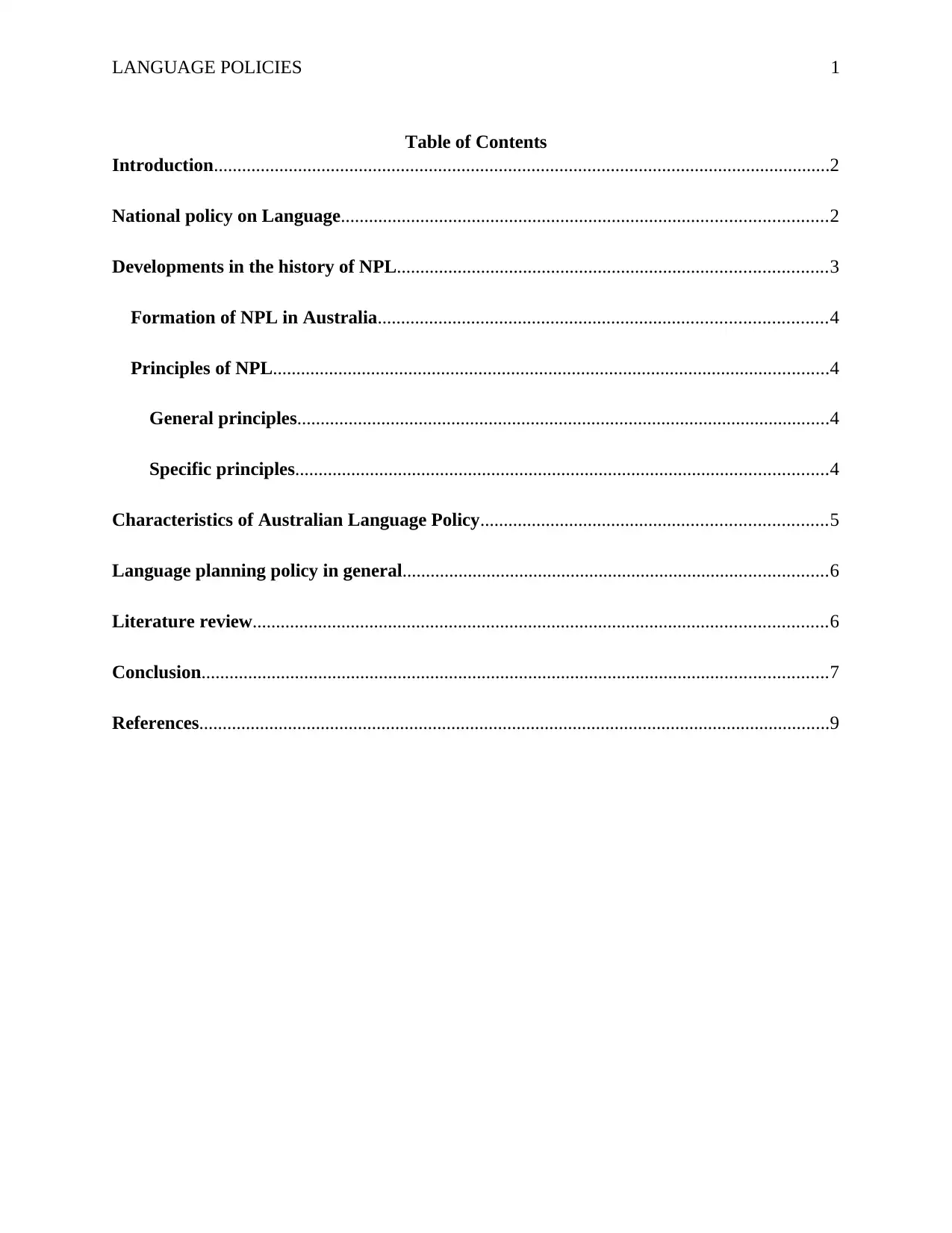
LANGUAGE POLICIES 1
Table of Contents
Introduction....................................................................................................................................2
National policy on Language........................................................................................................2
Developments in the history of NPL............................................................................................3
Formation of NPL in Australia................................................................................................4
Principles of NPL.......................................................................................................................4
General principles..................................................................................................................4
Specific principles..................................................................................................................4
Characteristics of Australian Language Policy..........................................................................5
Language planning policy in general...........................................................................................6
Literature review...........................................................................................................................6
Conclusion......................................................................................................................................7
References.......................................................................................................................................9
Table of Contents
Introduction....................................................................................................................................2
National policy on Language........................................................................................................2
Developments in the history of NPL............................................................................................3
Formation of NPL in Australia................................................................................................4
Principles of NPL.......................................................................................................................4
General principles..................................................................................................................4
Specific principles..................................................................................................................4
Characteristics of Australian Language Policy..........................................................................5
Language planning policy in general...........................................................................................6
Literature review...........................................................................................................................6
Conclusion......................................................................................................................................7
References.......................................................................................................................................9
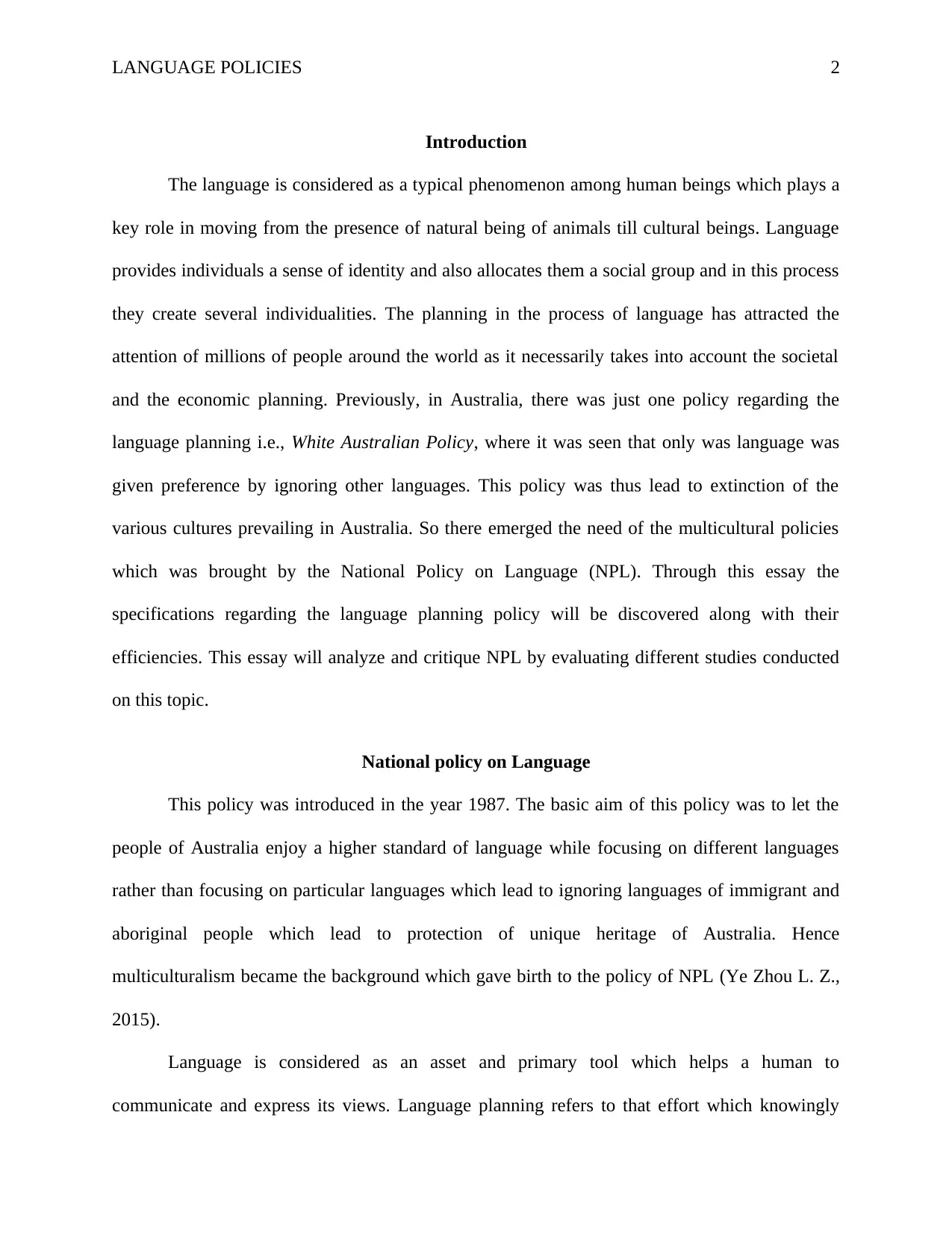
LANGUAGE POLICIES 2
Introduction
The language is considered as a typical phenomenon among human beings which plays a
key role in moving from the presence of natural being of animals till cultural beings. Language
provides individuals a sense of identity and also allocates them a social group and in this process
they create several individualities. The planning in the process of language has attracted the
attention of millions of people around the world as it necessarily takes into account the societal
and the economic planning. Previously, in Australia, there was just one policy regarding the
language planning i.e., White Australian Policy, where it was seen that only was language was
given preference by ignoring other languages. This policy was thus lead to extinction of the
various cultures prevailing in Australia. So there emerged the need of the multicultural policies
which was brought by the National Policy on Language (NPL). Through this essay the
specifications regarding the language planning policy will be discovered along with their
efficiencies. This essay will analyze and critique NPL by evaluating different studies conducted
on this topic.
National policy on Language
This policy was introduced in the year 1987. The basic aim of this policy was to let the
people of Australia enjoy a higher standard of language while focusing on different languages
rather than focusing on particular languages which lead to ignoring languages of immigrant and
aboriginal people which lead to protection of unique heritage of Australia. Hence
multiculturalism became the background which gave birth to the policy of NPL (Ye Zhou L. Z.,
2015).
Language is considered as an asset and primary tool which helps a human to
communicate and express its views. Language planning refers to that effort which knowingly
Introduction
The language is considered as a typical phenomenon among human beings which plays a
key role in moving from the presence of natural being of animals till cultural beings. Language
provides individuals a sense of identity and also allocates them a social group and in this process
they create several individualities. The planning in the process of language has attracted the
attention of millions of people around the world as it necessarily takes into account the societal
and the economic planning. Previously, in Australia, there was just one policy regarding the
language planning i.e., White Australian Policy, where it was seen that only was language was
given preference by ignoring other languages. This policy was thus lead to extinction of the
various cultures prevailing in Australia. So there emerged the need of the multicultural policies
which was brought by the National Policy on Language (NPL). Through this essay the
specifications regarding the language planning policy will be discovered along with their
efficiencies. This essay will analyze and critique NPL by evaluating different studies conducted
on this topic.
National policy on Language
This policy was introduced in the year 1987. The basic aim of this policy was to let the
people of Australia enjoy a higher standard of language while focusing on different languages
rather than focusing on particular languages which lead to ignoring languages of immigrant and
aboriginal people which lead to protection of unique heritage of Australia. Hence
multiculturalism became the background which gave birth to the policy of NPL (Ye Zhou L. Z.,
2015).
Language is considered as an asset and primary tool which helps a human to
communicate and express its views. Language planning refers to that effort which knowingly
⊘ This is a preview!⊘
Do you want full access?
Subscribe today to unlock all pages.

Trusted by 1+ million students worldwide
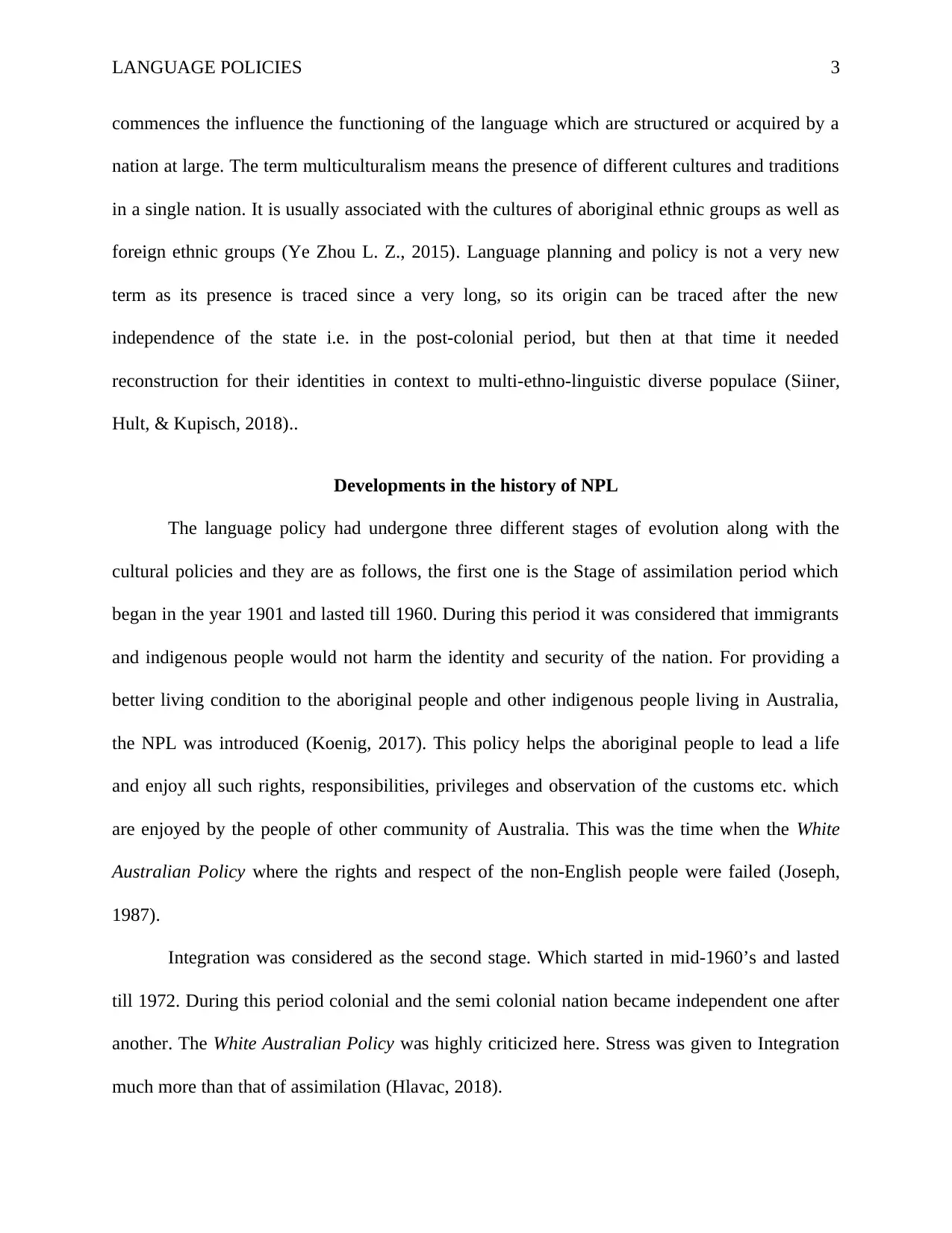
LANGUAGE POLICIES 3
commences the influence the functioning of the language which are structured or acquired by a
nation at large. The term multiculturalism means the presence of different cultures and traditions
in a single nation. It is usually associated with the cultures of aboriginal ethnic groups as well as
foreign ethnic groups (Ye Zhou L. Z., 2015). Language planning and policy is not a very new
term as its presence is traced since a very long, so its origin can be traced after the new
independence of the state i.e. in the post-colonial period, but then at that time it needed
reconstruction for their identities in context to multi-ethno-linguistic diverse populace (Siiner,
Hult, & Kupisch, 2018)..
Developments in the history of NPL
The language policy had undergone three different stages of evolution along with the
cultural policies and they are as follows, the first one is the Stage of assimilation period which
began in the year 1901 and lasted till 1960. During this period it was considered that immigrants
and indigenous people would not harm the identity and security of the nation. For providing a
better living condition to the aboriginal people and other indigenous people living in Australia,
the NPL was introduced (Koenig, 2017). This policy helps the aboriginal people to lead a life
and enjoy all such rights, responsibilities, privileges and observation of the customs etc. which
are enjoyed by the people of other community of Australia. This was the time when the White
Australian Policy where the rights and respect of the non-English people were failed (Joseph,
1987).
Integration was considered as the second stage. Which started in mid-1960’s and lasted
till 1972. During this period colonial and the semi colonial nation became independent one after
another. The White Australian Policy was highly criticized here. Stress was given to Integration
much more than that of assimilation (Hlavac, 2018).
commences the influence the functioning of the language which are structured or acquired by a
nation at large. The term multiculturalism means the presence of different cultures and traditions
in a single nation. It is usually associated with the cultures of aboriginal ethnic groups as well as
foreign ethnic groups (Ye Zhou L. Z., 2015). Language planning and policy is not a very new
term as its presence is traced since a very long, so its origin can be traced after the new
independence of the state i.e. in the post-colonial period, but then at that time it needed
reconstruction for their identities in context to multi-ethno-linguistic diverse populace (Siiner,
Hult, & Kupisch, 2018)..
Developments in the history of NPL
The language policy had undergone three different stages of evolution along with the
cultural policies and they are as follows, the first one is the Stage of assimilation period which
began in the year 1901 and lasted till 1960. During this period it was considered that immigrants
and indigenous people would not harm the identity and security of the nation. For providing a
better living condition to the aboriginal people and other indigenous people living in Australia,
the NPL was introduced (Koenig, 2017). This policy helps the aboriginal people to lead a life
and enjoy all such rights, responsibilities, privileges and observation of the customs etc. which
are enjoyed by the people of other community of Australia. This was the time when the White
Australian Policy where the rights and respect of the non-English people were failed (Joseph,
1987).
Integration was considered as the second stage. Which started in mid-1960’s and lasted
till 1972. During this period colonial and the semi colonial nation became independent one after
another. The White Australian Policy was highly criticized here. Stress was given to Integration
much more than that of assimilation (Hlavac, 2018).
Paraphrase This Document
Need a fresh take? Get an instant paraphrase of this document with our AI Paraphraser
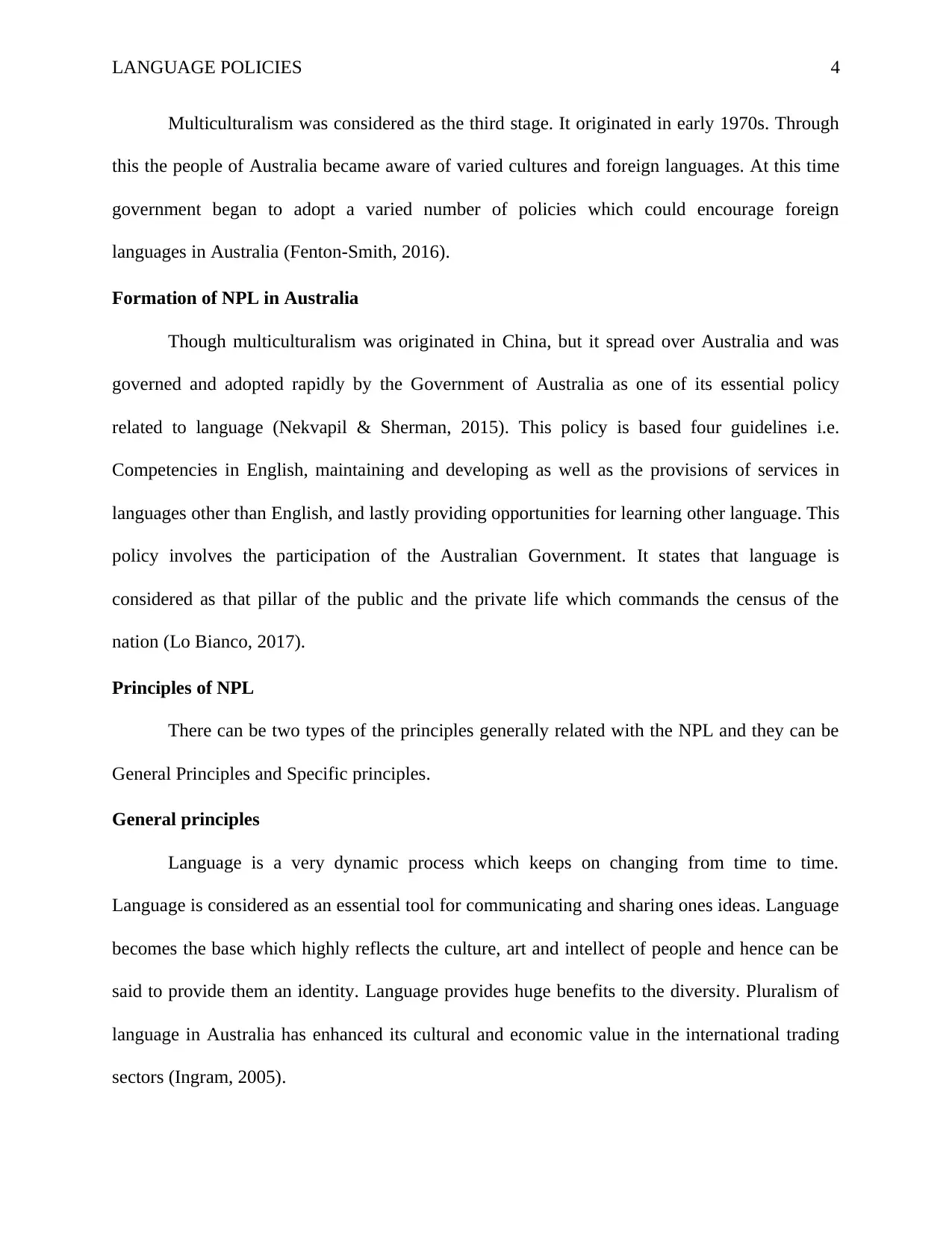
LANGUAGE POLICIES 4
Multiculturalism was considered as the third stage. It originated in early 1970s. Through
this the people of Australia became aware of varied cultures and foreign languages. At this time
government began to adopt a varied number of policies which could encourage foreign
languages in Australia (Fenton-Smith, 2016).
Formation of NPL in Australia
Though multiculturalism was originated in China, but it spread over Australia and was
governed and adopted rapidly by the Government of Australia as one of its essential policy
related to language (Nekvapil & Sherman, 2015). This policy is based four guidelines i.e.
Competencies in English, maintaining and developing as well as the provisions of services in
languages other than English, and lastly providing opportunities for learning other language. This
policy involves the participation of the Australian Government. It states that language is
considered as that pillar of the public and the private life which commands the census of the
nation (Lo Bianco, 2017).
Principles of NPL
There can be two types of the principles generally related with the NPL and they can be
General Principles and Specific principles.
General principles
Language is a very dynamic process which keeps on changing from time to time.
Language is considered as an essential tool for communicating and sharing ones ideas. Language
becomes the base which highly reflects the culture, art and intellect of people and hence can be
said to provide them an identity. Language provides huge benefits to the diversity. Pluralism of
language in Australia has enhanced its cultural and economic value in the international trading
sectors (Ingram, 2005).
Multiculturalism was considered as the third stage. It originated in early 1970s. Through
this the people of Australia became aware of varied cultures and foreign languages. At this time
government began to adopt a varied number of policies which could encourage foreign
languages in Australia (Fenton-Smith, 2016).
Formation of NPL in Australia
Though multiculturalism was originated in China, but it spread over Australia and was
governed and adopted rapidly by the Government of Australia as one of its essential policy
related to language (Nekvapil & Sherman, 2015). This policy is based four guidelines i.e.
Competencies in English, maintaining and developing as well as the provisions of services in
languages other than English, and lastly providing opportunities for learning other language. This
policy involves the participation of the Australian Government. It states that language is
considered as that pillar of the public and the private life which commands the census of the
nation (Lo Bianco, 2017).
Principles of NPL
There can be two types of the principles generally related with the NPL and they can be
General Principles and Specific principles.
General principles
Language is a very dynamic process which keeps on changing from time to time.
Language is considered as an essential tool for communicating and sharing ones ideas. Language
becomes the base which highly reflects the culture, art and intellect of people and hence can be
said to provide them an identity. Language provides huge benefits to the diversity. Pluralism of
language in Australia has enhanced its cultural and economic value in the international trading
sectors (Ingram, 2005).
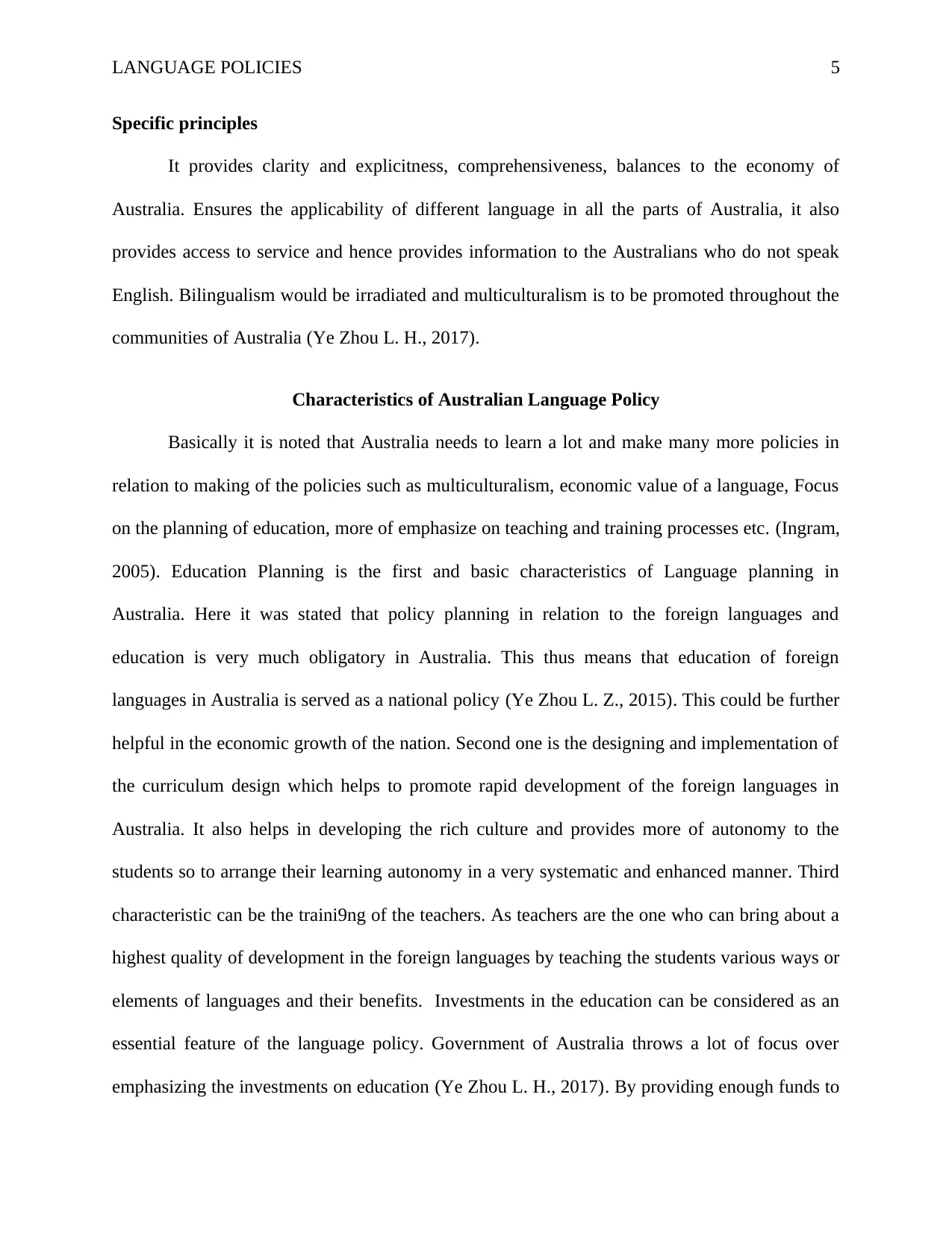
LANGUAGE POLICIES 5
Specific principles
It provides clarity and explicitness, comprehensiveness, balances to the economy of
Australia. Ensures the applicability of different language in all the parts of Australia, it also
provides access to service and hence provides information to the Australians who do not speak
English. Bilingualism would be irradiated and multiculturalism is to be promoted throughout the
communities of Australia (Ye Zhou L. H., 2017).
Characteristics of Australian Language Policy
Basically it is noted that Australia needs to learn a lot and make many more policies in
relation to making of the policies such as multiculturalism, economic value of a language, Focus
on the planning of education, more of emphasize on teaching and training processes etc. (Ingram,
2005). Education Planning is the first and basic characteristics of Language planning in
Australia. Here it was stated that policy planning in relation to the foreign languages and
education is very much obligatory in Australia. This thus means that education of foreign
languages in Australia is served as a national policy (Ye Zhou L. Z., 2015). This could be further
helpful in the economic growth of the nation. Second one is the designing and implementation of
the curriculum design which helps to promote rapid development of the foreign languages in
Australia. It also helps in developing the rich culture and provides more of autonomy to the
students so to arrange their learning autonomy in a very systematic and enhanced manner. Third
characteristic can be the traini9ng of the teachers. As teachers are the one who can bring about a
highest quality of development in the foreign languages by teaching the students various ways or
elements of languages and their benefits. Investments in the education can be considered as an
essential feature of the language policy. Government of Australia throws a lot of focus over
emphasizing the investments on education (Ye Zhou L. H., 2017). By providing enough funds to
Specific principles
It provides clarity and explicitness, comprehensiveness, balances to the economy of
Australia. Ensures the applicability of different language in all the parts of Australia, it also
provides access to service and hence provides information to the Australians who do not speak
English. Bilingualism would be irradiated and multiculturalism is to be promoted throughout the
communities of Australia (Ye Zhou L. H., 2017).
Characteristics of Australian Language Policy
Basically it is noted that Australia needs to learn a lot and make many more policies in
relation to making of the policies such as multiculturalism, economic value of a language, Focus
on the planning of education, more of emphasize on teaching and training processes etc. (Ingram,
2005). Education Planning is the first and basic characteristics of Language planning in
Australia. Here it was stated that policy planning in relation to the foreign languages and
education is very much obligatory in Australia. This thus means that education of foreign
languages in Australia is served as a national policy (Ye Zhou L. Z., 2015). This could be further
helpful in the economic growth of the nation. Second one is the designing and implementation of
the curriculum design which helps to promote rapid development of the foreign languages in
Australia. It also helps in developing the rich culture and provides more of autonomy to the
students so to arrange their learning autonomy in a very systematic and enhanced manner. Third
characteristic can be the traini9ng of the teachers. As teachers are the one who can bring about a
highest quality of development in the foreign languages by teaching the students various ways or
elements of languages and their benefits. Investments in the education can be considered as an
essential feature of the language policy. Government of Australia throws a lot of focus over
emphasizing the investments on education (Ye Zhou L. H., 2017). By providing enough funds to
⊘ This is a preview!⊘
Do you want full access?
Subscribe today to unlock all pages.

Trusted by 1+ million students worldwide
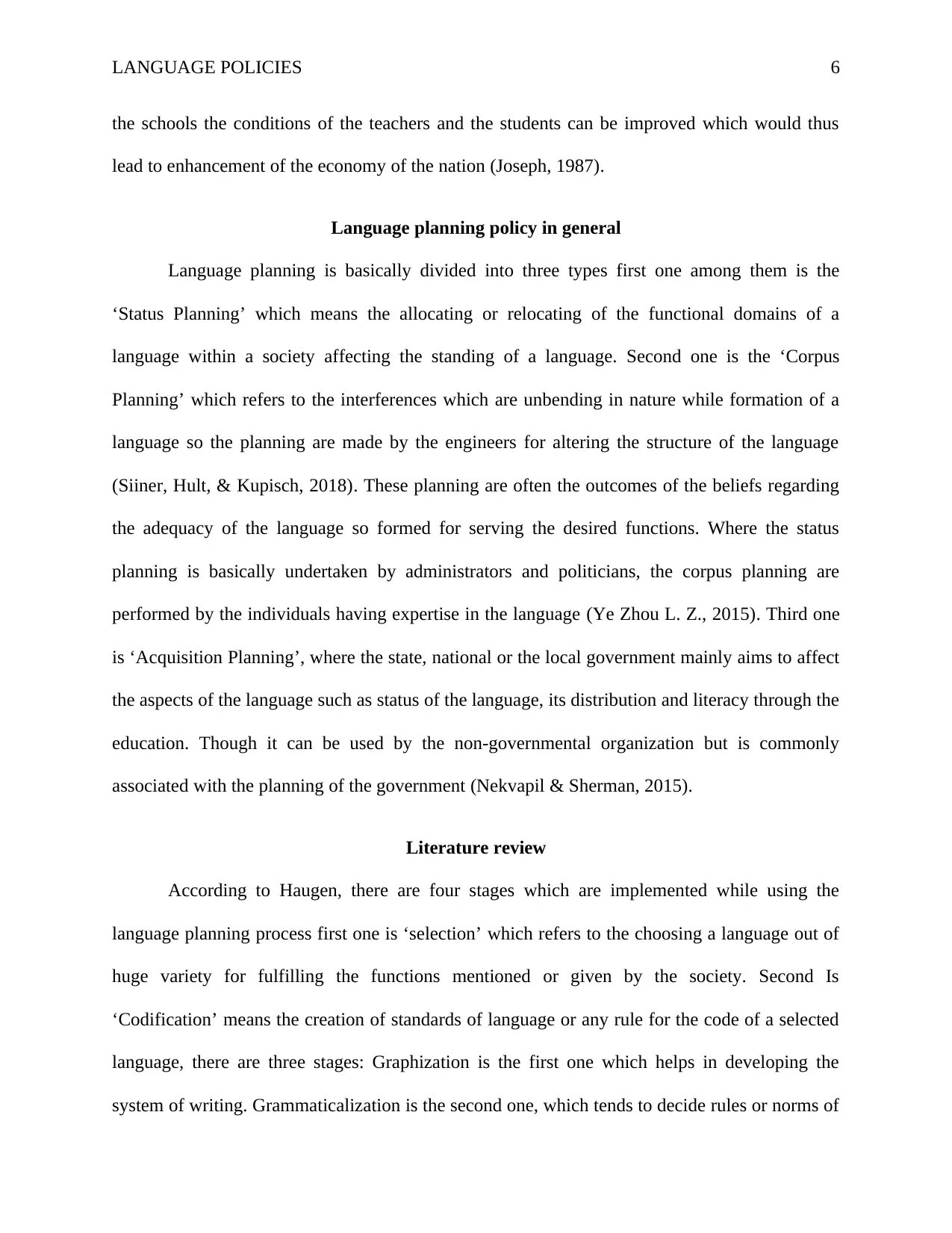
LANGUAGE POLICIES 6
the schools the conditions of the teachers and the students can be improved which would thus
lead to enhancement of the economy of the nation (Joseph, 1987).
Language planning policy in general
Language planning is basically divided into three types first one among them is the
‘Status Planning’ which means the allocating or relocating of the functional domains of a
language within a society affecting the standing of a language. Second one is the ‘Corpus
Planning’ which refers to the interferences which are unbending in nature while formation of a
language so the planning are made by the engineers for altering the structure of the language
(Siiner, Hult, & Kupisch, 2018). These planning are often the outcomes of the beliefs regarding
the adequacy of the language so formed for serving the desired functions. Where the status
planning is basically undertaken by administrators and politicians, the corpus planning are
performed by the individuals having expertise in the language (Ye Zhou L. Z., 2015). Third one
is ‘Acquisition Planning’, where the state, national or the local government mainly aims to affect
the aspects of the language such as status of the language, its distribution and literacy through the
education. Though it can be used by the non-governmental organization but is commonly
associated with the planning of the government (Nekvapil & Sherman, 2015).
Literature review
According to Haugen, there are four stages which are implemented while using the
language planning process first one is ‘selection’ which refers to the choosing a language out of
huge variety for fulfilling the functions mentioned or given by the society. Second Is
‘Codification’ means the creation of standards of language or any rule for the code of a selected
language, there are three stages: Graphization is the first one which helps in developing the
system of writing. Grammaticalization is the second one, which tends to decide rules or norms of
the schools the conditions of the teachers and the students can be improved which would thus
lead to enhancement of the economy of the nation (Joseph, 1987).
Language planning policy in general
Language planning is basically divided into three types first one among them is the
‘Status Planning’ which means the allocating or relocating of the functional domains of a
language within a society affecting the standing of a language. Second one is the ‘Corpus
Planning’ which refers to the interferences which are unbending in nature while formation of a
language so the planning are made by the engineers for altering the structure of the language
(Siiner, Hult, & Kupisch, 2018). These planning are often the outcomes of the beliefs regarding
the adequacy of the language so formed for serving the desired functions. Where the status
planning is basically undertaken by administrators and politicians, the corpus planning are
performed by the individuals having expertise in the language (Ye Zhou L. Z., 2015). Third one
is ‘Acquisition Planning’, where the state, national or the local government mainly aims to affect
the aspects of the language such as status of the language, its distribution and literacy through the
education. Though it can be used by the non-governmental organization but is commonly
associated with the planning of the government (Nekvapil & Sherman, 2015).
Literature review
According to Haugen, there are four stages which are implemented while using the
language planning process first one is ‘selection’ which refers to the choosing a language out of
huge variety for fulfilling the functions mentioned or given by the society. Second Is
‘Codification’ means the creation of standards of language or any rule for the code of a selected
language, there are three stages: Graphization is the first one which helps in developing the
system of writing. Grammaticalization is the second one, which tends to decide rules or norms of
Paraphrase This Document
Need a fresh take? Get an instant paraphrase of this document with our AI Paraphraser
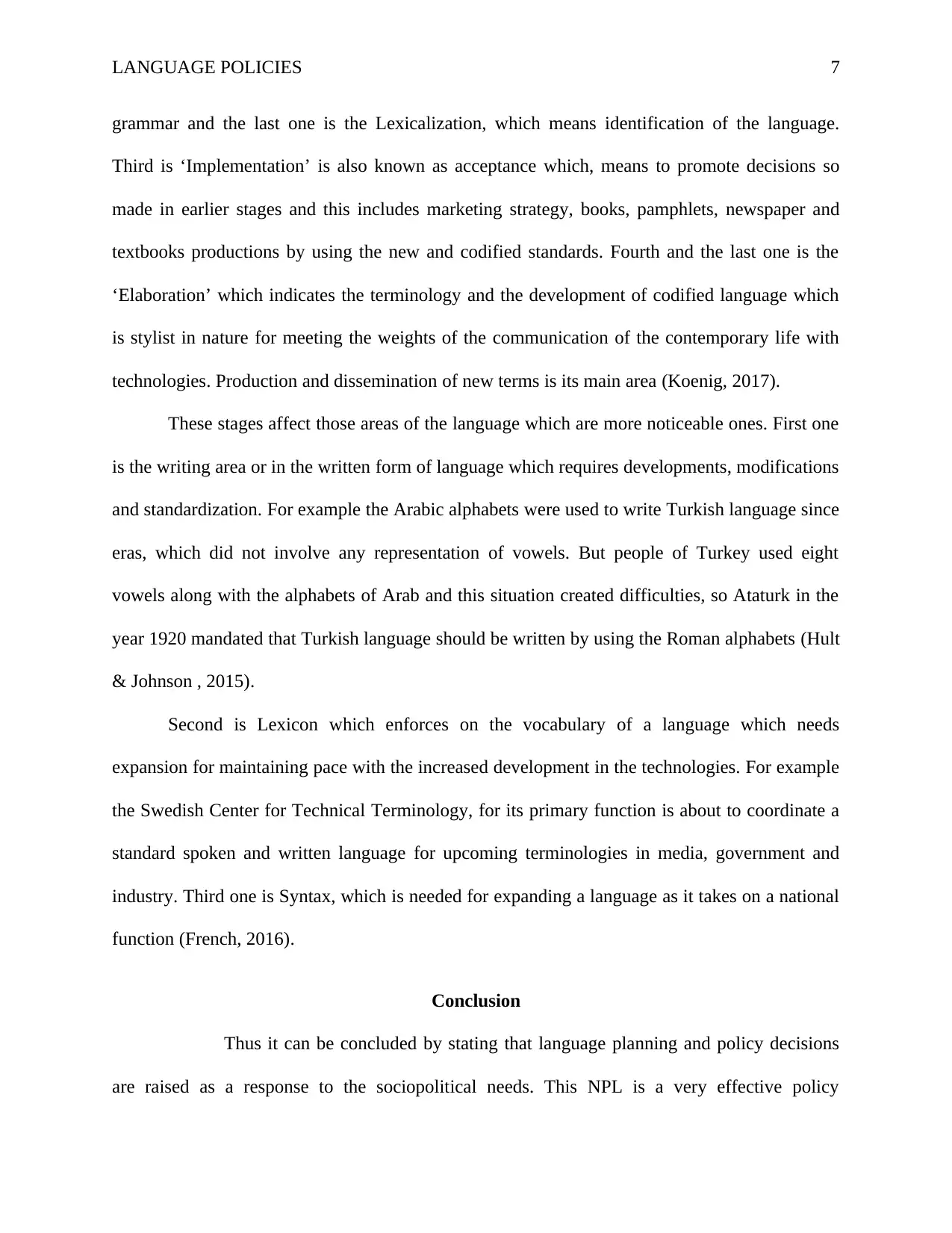
LANGUAGE POLICIES 7
grammar and the last one is the Lexicalization, which means identification of the language.
Third is ‘Implementation’ is also known as acceptance which, means to promote decisions so
made in earlier stages and this includes marketing strategy, books, pamphlets, newspaper and
textbooks productions by using the new and codified standards. Fourth and the last one is the
‘Elaboration’ which indicates the terminology and the development of codified language which
is stylist in nature for meeting the weights of the communication of the contemporary life with
technologies. Production and dissemination of new terms is its main area (Koenig, 2017).
These stages affect those areas of the language which are more noticeable ones. First one
is the writing area or in the written form of language which requires developments, modifications
and standardization. For example the Arabic alphabets were used to write Turkish language since
eras, which did not involve any representation of vowels. But people of Turkey used eight
vowels along with the alphabets of Arab and this situation created difficulties, so Ataturk in the
year 1920 mandated that Turkish language should be written by using the Roman alphabets (Hult
& Johnson , 2015).
Second is Lexicon which enforces on the vocabulary of a language which needs
expansion for maintaining pace with the increased development in the technologies. For example
the Swedish Center for Technical Terminology, for its primary function is about to coordinate a
standard spoken and written language for upcoming terminologies in media, government and
industry. Third one is Syntax, which is needed for expanding a language as it takes on a national
function (French, 2016).
Conclusion
Thus it can be concluded by stating that language planning and policy decisions
are raised as a response to the sociopolitical needs. This NPL is a very effective policy
grammar and the last one is the Lexicalization, which means identification of the language.
Third is ‘Implementation’ is also known as acceptance which, means to promote decisions so
made in earlier stages and this includes marketing strategy, books, pamphlets, newspaper and
textbooks productions by using the new and codified standards. Fourth and the last one is the
‘Elaboration’ which indicates the terminology and the development of codified language which
is stylist in nature for meeting the weights of the communication of the contemporary life with
technologies. Production and dissemination of new terms is its main area (Koenig, 2017).
These stages affect those areas of the language which are more noticeable ones. First one
is the writing area or in the written form of language which requires developments, modifications
and standardization. For example the Arabic alphabets were used to write Turkish language since
eras, which did not involve any representation of vowels. But people of Turkey used eight
vowels along with the alphabets of Arab and this situation created difficulties, so Ataturk in the
year 1920 mandated that Turkish language should be written by using the Roman alphabets (Hult
& Johnson , 2015).
Second is Lexicon which enforces on the vocabulary of a language which needs
expansion for maintaining pace with the increased development in the technologies. For example
the Swedish Center for Technical Terminology, for its primary function is about to coordinate a
standard spoken and written language for upcoming terminologies in media, government and
industry. Third one is Syntax, which is needed for expanding a language as it takes on a national
function (French, 2016).
Conclusion
Thus it can be concluded by stating that language planning and policy decisions
are raised as a response to the sociopolitical needs. This NPL is a very effective policy
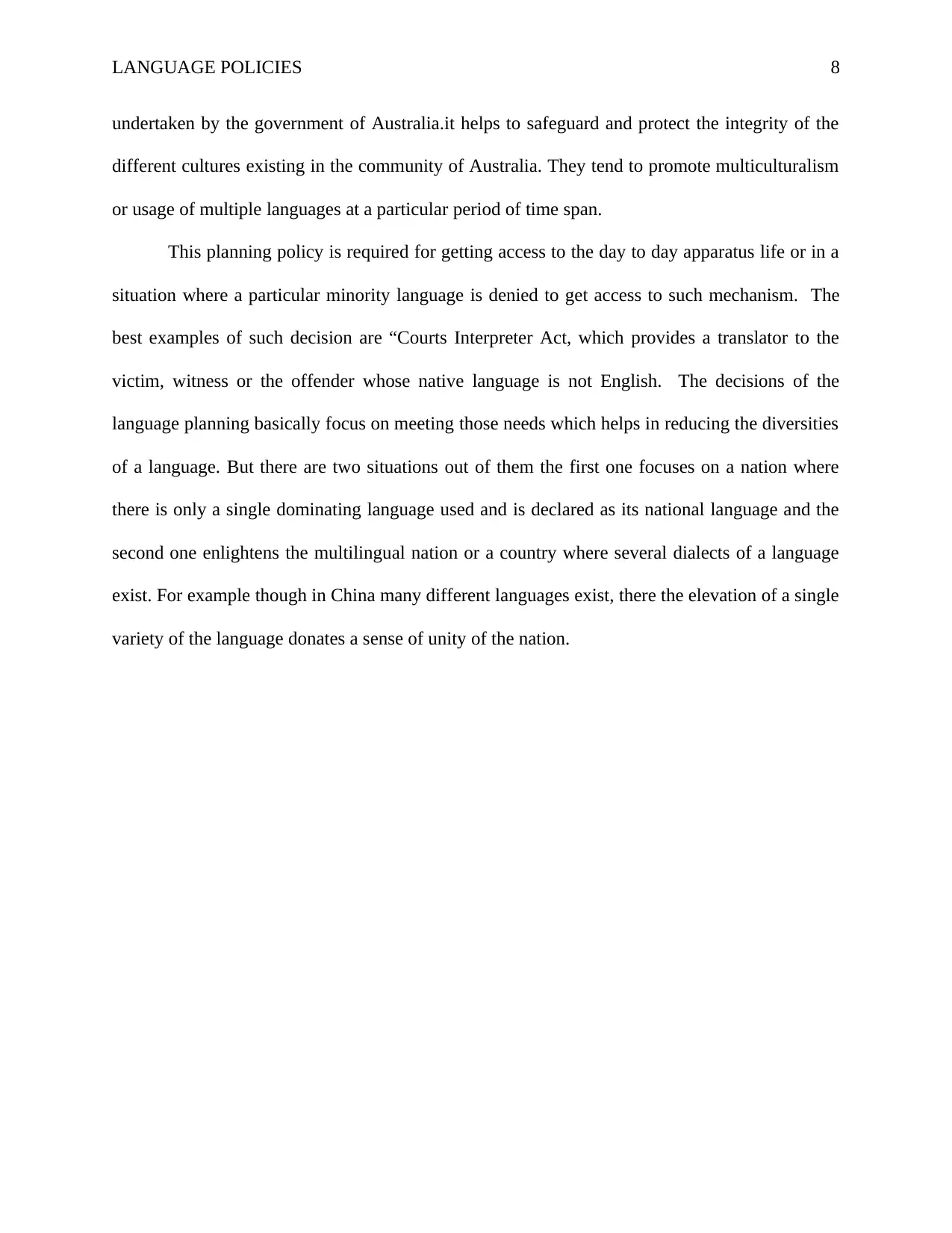
LANGUAGE POLICIES 8
undertaken by the government of Australia.it helps to safeguard and protect the integrity of the
different cultures existing in the community of Australia. They tend to promote multiculturalism
or usage of multiple languages at a particular period of time span.
This planning policy is required for getting access to the day to day apparatus life or in a
situation where a particular minority language is denied to get access to such mechanism. The
best examples of such decision are “Courts Interpreter Act, which provides a translator to the
victim, witness or the offender whose native language is not English. The decisions of the
language planning basically focus on meeting those needs which helps in reducing the diversities
of a language. But there are two situations out of them the first one focuses on a nation where
there is only a single dominating language used and is declared as its national language and the
second one enlightens the multilingual nation or a country where several dialects of a language
exist. For example though in China many different languages exist, there the elevation of a single
variety of the language donates a sense of unity of the nation.
undertaken by the government of Australia.it helps to safeguard and protect the integrity of the
different cultures existing in the community of Australia. They tend to promote multiculturalism
or usage of multiple languages at a particular period of time span.
This planning policy is required for getting access to the day to day apparatus life or in a
situation where a particular minority language is denied to get access to such mechanism. The
best examples of such decision are “Courts Interpreter Act, which provides a translator to the
victim, witness or the offender whose native language is not English. The decisions of the
language planning basically focus on meeting those needs which helps in reducing the diversities
of a language. But there are two situations out of them the first one focuses on a nation where
there is only a single dominating language used and is declared as its national language and the
second one enlightens the multilingual nation or a country where several dialects of a language
exist. For example though in China many different languages exist, there the elevation of a single
variety of the language donates a sense of unity of the nation.
⊘ This is a preview!⊘
Do you want full access?
Subscribe today to unlock all pages.

Trusted by 1+ million students worldwide
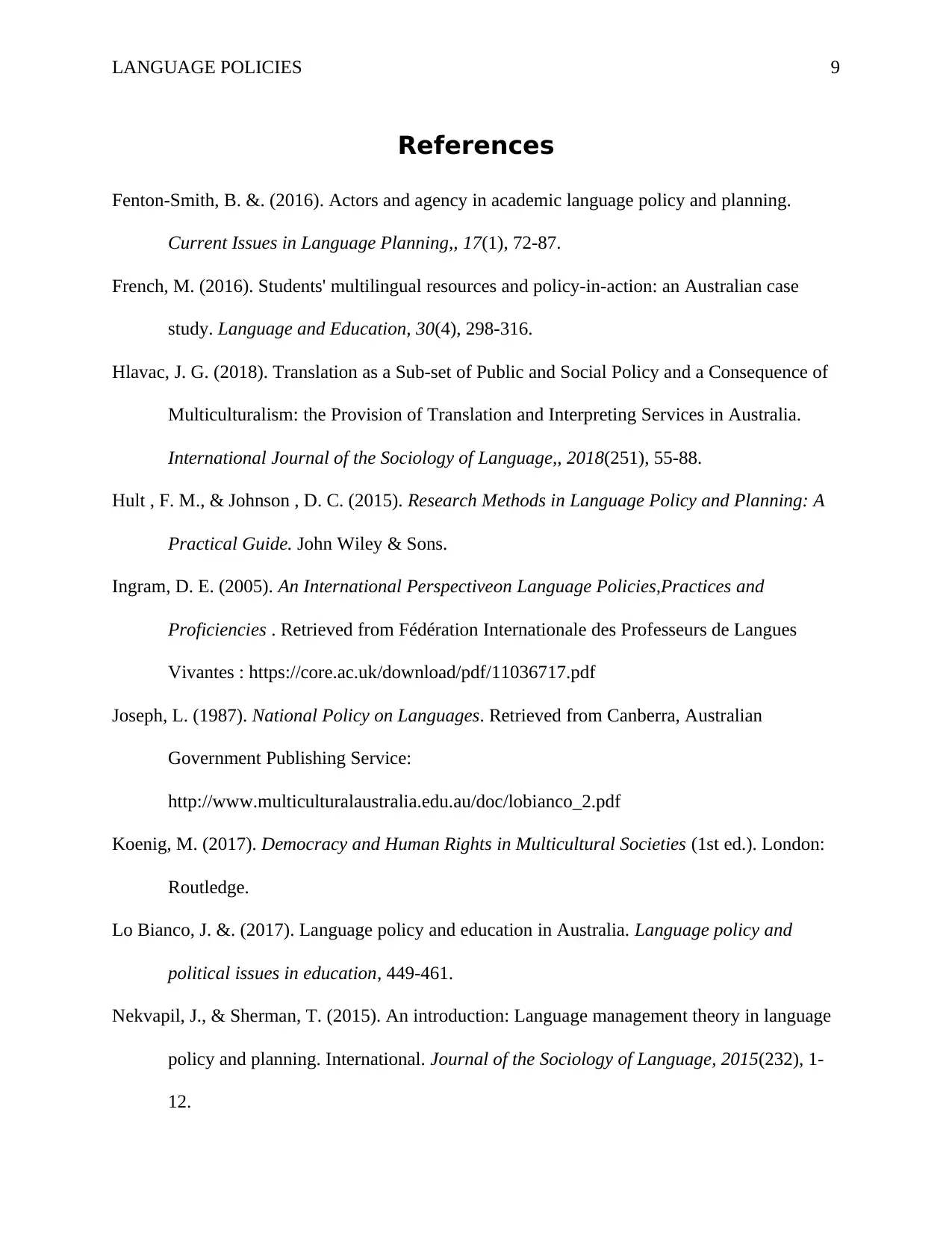
LANGUAGE POLICIES 9
References
Fenton-Smith, B. &. (2016). Actors and agency in academic language policy and planning.
Current Issues in Language Planning,, 17(1), 72-87.
French, M. (2016). Students' multilingual resources and policy-in-action: an Australian case
study. Language and Education, 30(4), 298-316.
Hlavac, J. G. (2018). Translation as a Sub-set of Public and Social Policy and a Consequence of
Multiculturalism: the Provision of Translation and Interpreting Services in Australia.
International Journal of the Sociology of Language,, 2018(251), 55-88.
Hult , F. M., & Johnson , D. C. (2015). Research Methods in Language Policy and Planning: A
Practical Guide. John Wiley & Sons.
Ingram, D. E. (2005). An International Perspectiveon Language Policies,Practices and
Proficiencies . Retrieved from Fédération Internationale des Professeurs de Langues
Vivantes : https://core.ac.uk/download/pdf/11036717.pdf
Joseph, L. (1987). National Policy on Languages. Retrieved from Canberra, Australian
Government Publishing Service:
http://www.multiculturalaustralia.edu.au/doc/lobianco_2.pdf
Koenig, M. (2017). Democracy and Human Rights in Multicultural Societies (1st ed.). London:
Routledge.
Lo Bianco, J. &. (2017). Language policy and education in Australia. Language policy and
political issues in education, 449-461.
Nekvapil, J., & Sherman, T. (2015). An introduction: Language management theory in language
policy and planning. International. Journal of the Sociology of Language, 2015(232), 1-
12.
References
Fenton-Smith, B. &. (2016). Actors and agency in academic language policy and planning.
Current Issues in Language Planning,, 17(1), 72-87.
French, M. (2016). Students' multilingual resources and policy-in-action: an Australian case
study. Language and Education, 30(4), 298-316.
Hlavac, J. G. (2018). Translation as a Sub-set of Public and Social Policy and a Consequence of
Multiculturalism: the Provision of Translation and Interpreting Services in Australia.
International Journal of the Sociology of Language,, 2018(251), 55-88.
Hult , F. M., & Johnson , D. C. (2015). Research Methods in Language Policy and Planning: A
Practical Guide. John Wiley & Sons.
Ingram, D. E. (2005). An International Perspectiveon Language Policies,Practices and
Proficiencies . Retrieved from Fédération Internationale des Professeurs de Langues
Vivantes : https://core.ac.uk/download/pdf/11036717.pdf
Joseph, L. (1987). National Policy on Languages. Retrieved from Canberra, Australian
Government Publishing Service:
http://www.multiculturalaustralia.edu.au/doc/lobianco_2.pdf
Koenig, M. (2017). Democracy and Human Rights in Multicultural Societies (1st ed.). London:
Routledge.
Lo Bianco, J. &. (2017). Language policy and education in Australia. Language policy and
political issues in education, 449-461.
Nekvapil, J., & Sherman, T. (2015). An introduction: Language management theory in language
policy and planning. International. Journal of the Sociology of Language, 2015(232), 1-
12.
Paraphrase This Document
Need a fresh take? Get an instant paraphrase of this document with our AI Paraphraser
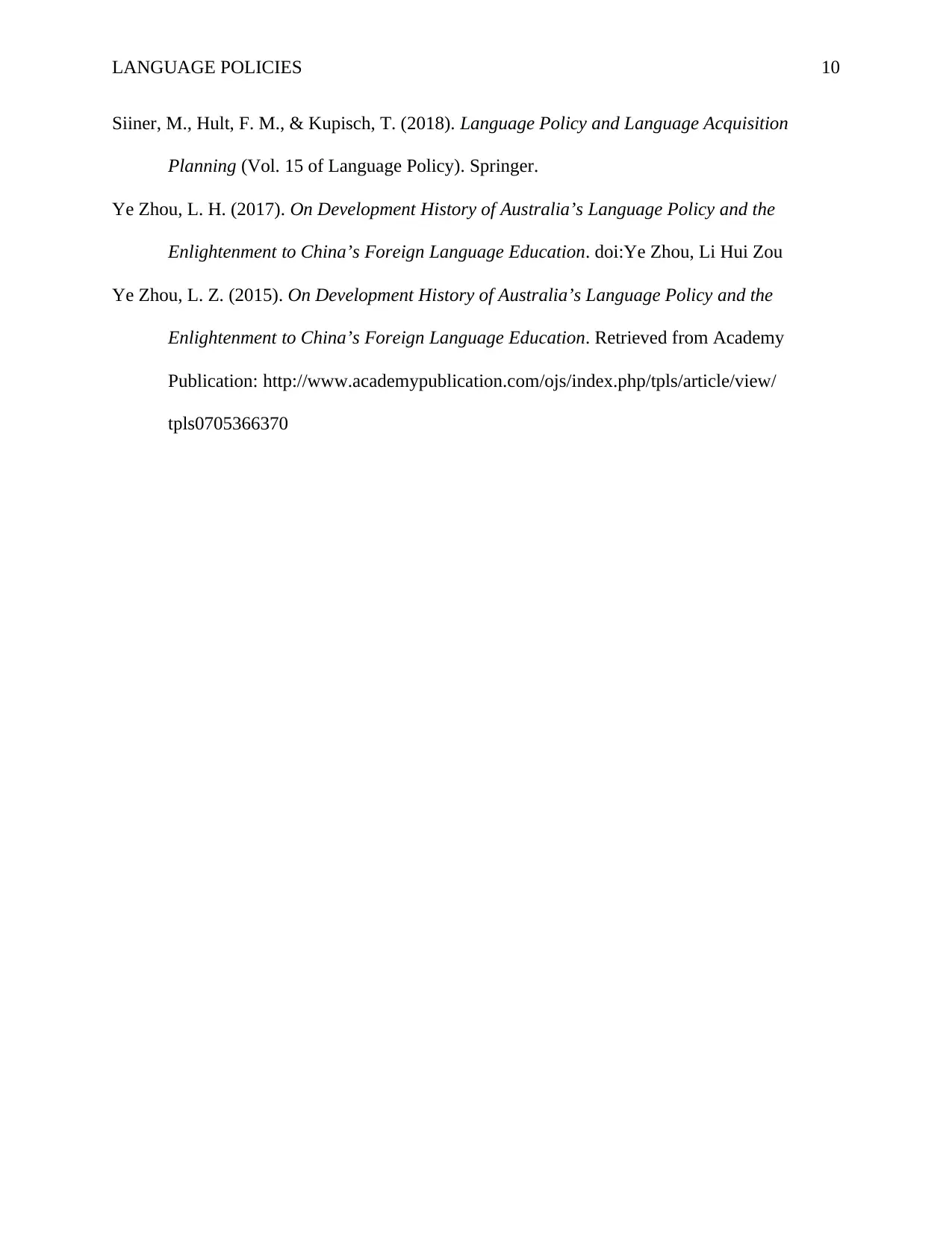
LANGUAGE POLICIES 10
Siiner, M., Hult, F. M., & Kupisch, T. (2018). Language Policy and Language Acquisition
Planning (Vol. 15 of Language Policy). Springer.
Ye Zhou, L. H. (2017). On Development History of Australia’s Language Policy and the
Enlightenment to China’s Foreign Language Education. doi:Ye Zhou, Li Hui Zou
Ye Zhou, L. Z. (2015). On Development History of Australia’s Language Policy and the
Enlightenment to China’s Foreign Language Education. Retrieved from Academy
Publication: http://www.academypublication.com/ojs/index.php/tpls/article/view/
tpls0705366370
Siiner, M., Hult, F. M., & Kupisch, T. (2018). Language Policy and Language Acquisition
Planning (Vol. 15 of Language Policy). Springer.
Ye Zhou, L. H. (2017). On Development History of Australia’s Language Policy and the
Enlightenment to China’s Foreign Language Education. doi:Ye Zhou, Li Hui Zou
Ye Zhou, L. Z. (2015). On Development History of Australia’s Language Policy and the
Enlightenment to China’s Foreign Language Education. Retrieved from Academy
Publication: http://www.academypublication.com/ojs/index.php/tpls/article/view/
tpls0705366370
1 out of 11
Your All-in-One AI-Powered Toolkit for Academic Success.
+13062052269
info@desklib.com
Available 24*7 on WhatsApp / Email
![[object Object]](/_next/static/media/star-bottom.7253800d.svg)
Unlock your academic potential
Copyright © 2020–2025 A2Z Services. All Rights Reserved. Developed and managed by ZUCOL.

